Introduction
Children have enjoyed playing with wooden toys for generations and tend to not go out of style as many other toys.
Natural toys made from wood and other sustainable materials are becoming more popular as people start to become more conscious about their environment.
You don’t need to be a Waldorf or Montessori parent to be interested in wooden toys.
I slowly started transitioning into natural toys for my daughter several years ago more because I wanted to avoid plastics and unnecessary chemicals and additives in our home and around her. There was also something nostalgic about choosing wooden toys.
My son was born just over two years ago, and it was amazing to see how much the variety of wooden toys had increased.
When something, like wooden toys, in this case, becomes more popular and trendy, so does the amount of low-quality, and counterfeit products.
By reading this post you will learn about how to make sure you are buying high-quality wooden toys that are free from harsh chemicals and will last for a long time.
Most homes today are full of plastic toys. At the end of the article I will dig into the different plastic types, and which plastic toys are better than others, and which ones you may want to get rid of.

Wooden Toys
When you are choosing toys in general, it’s essential to know how the toy is going to be used and by whom. Here are a couple of points to keep in mind. Is the toy:
- Going to be used by a baby and end up in a mouth?
- Suitable for the age and development of the child?
- Safe? Does it have any sharp objects or splinters?

Why wooden toys?
Wooden toys are a great natural option and can tick many boxes like being environmentally-friendly, biodegradable, sustainable/renewable, durable, Waldorf- and Montessori-friendly, and last but not least beautiful.
They are also considered open-ended, which means they are excellent to encourage imagination and problem-solving. They tend to be more simple than plastic toys because they don’t always have smooth surfaces and straight lines, which leaves more room for creativity.
Wooden teethers are a great natural option for soothing the gum of a teething infant. The best type is hard maple wood.
We all know that our children can be quite rough on their toys. Apart from being safe, a toy needs to survive wear and tear, being put into mouths, being thrown on to the floor, many times. That’s why selecting the right wood matters.
Wood Types

Hardwood
Hardwood comes from trees like Birch, Balsa, Beech, Hickory, Maple, Oak, Teak, and Walnut. It is more expensive than softwood. The main advantage is it’s high density, and therefore, durability. Wooden toys made from it last very well and could be handed down for generations if taken well care of by the owner.
Maple wood is great as it is not likely to splinter, and is hypoallergenic. Some woods can cause allergic reactions through inhalation of the wood dust, or skin contact.
Rubberwood
Rubberwood comes from the rubber tree, and can mainly be found in countries like Thailand, Indonesia, and Brazil.
It is one of the most environmentally friendly wood as the rubber trees are only cut down for lumber when the trees have stopped producing latex sap, which is used for natural rubber making. New trees are then planted to replace them.
Softwood
Comes from trees like Cedar, Douglas Fir, Pine, Spruce, and Redwood. Softwood is more suitable for instruments and toys that do not need to tolerate as much wear and tear. It is cheaper, but are more likely to break and splinter, which can easily make the toy unsafe.
Composite wood
Many wooden toys are made from composite wood, which means the wood has been pressed together with chemicals or glues. Examples of timber like this are MDF, plywood, or pressed wood. It depends on the manufacturers which type of adhesives they use and how much chemicals they contain or how much off-gassing they introduce.
If you choose toys from composite wood, you want to make sure that the adhesive used doesn’t contain harsh chemicals. Some glues used, especially outside of Europe, may off-gas formaldehyde, which you want to avoid for your children.
Where does the wood come from? Is it Sustainable?

When choosing a wooden toy, make sure the wood comes from responsible, sustainable forests. It’s best if it has the FCS or PEFC certifications.
If you are not familiar with these certifications, they are designed to ensure an environmentally-friendly, economically feasible and socially beneficial forest management.
These are the logos you want to look for:
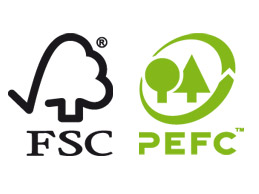
Wooden toys finishes and paint
Let’s start this chapter with an example of a recall from the US Consumer Products Safety Commission:
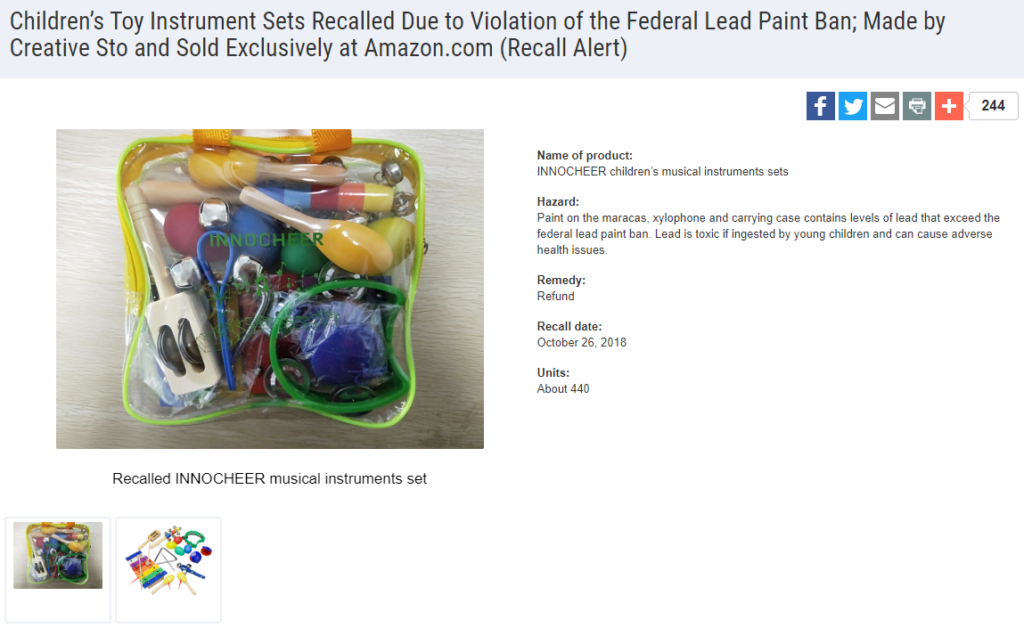
This example shows that wooden toys are not always as natural as we think. You might have chosen these wooden toys in good faith, believing you were buying a good toy.
We can see that this toy, was painted with lead-containing paint.
Ingested paint containing lead or lead dust is a hazard to children, which is the reason it has been banned for more than 30 years. However, toys from less regulated areas are still being imported to the US and Europe despite of regulations (see more below on regulations).
Your best weapon is to know the origin of the toy and if the manufacturer is using safe chemicals, and has certifications, like CE marking for their products.
If the wooden toy is made in China, be extra careful and see if the manufacturer has strict quality regulations, and make sure the product is tested, and allowed to be sold in Europe (since it has the strictest regulations).
You can also become a pretty good detective just by using your nose, if something has a very strong smell, it’s probably not good. Lead does not have any scent, but harsh chemicals usually do.
I know a friend of mine even licks the toys before her baby starts chewing on them, to make sure they are OK 🙂

It is most natural to choose a hardwood finished with natural oil or wax, like beeswax, olive, or walnut oil (if not allergic).
However, paint doesn’t always contain harsh chemicals, several paint types are perfectly fine.
The best options are plant- or water-based paints. Milk paint can also be a good option (if your child is not allergic).
You want to avoid strong plastic sealants and lacquers, especially if chances are that a small child will put the item into its mouth.
Paint is often made from plastic materials. If you are buying a wooden toy because you are avoiding plastics, you may want to think twice if the wooden toy is covered in plastic.
Ordering wooden toys from Amazon and Etsy
If you are ordering from Amazon, it’s essential to read the reviews. I was looking at a wooden rainbow from the Grimms company the other day, and I noticed how bad reviews it was getting from many buyers.
It turned out to be a fake one from China. It looked similar but started cracking after only being used for a few times. The real wooden toys from Grimm’s are very sturdy and last for a long time.
If you buy wooden toys from Etsy you want to check these things:
- Is the wooden toy made from hardwood?
- Does the maker use non-toxic glues?
- Does the maker use non-toxic sealants or paints?
- Is the toy sanded smooth, or is there a risk for splinters.
What about second-hand wooden toys?

Yes, second-hand toys can be excellent, especially for our environment.
However, the same applies to second-hand toys, as we were discussing above. You want to understand from which materials the toys are made.
The problem with second-hand toys is that you may not know the origin of the toy.
Another thing to keep in mind with old wooden toys is the paint. You want to make sure the paint does not contain lead, and that it is not flaking and ending up in your child’s mouth.
If the second-hand wooden toys are made from solid wood and are not painted you can follow the tips below to make them like new again.
How to care for and clean wooden toys

Wood has natural antibacterial properties, so it will not be as affected by germs as plastic toys. However, it’s good to clean them once in a while, especially if they are put into small mouths.
It’s good to use a gentle natural cleanser, like very mild dish soap, or vinegar (both white and apple cider work well).
You never want to soak wooden toys or immerse them in water. Instead, you want to gently wipe it down with a washcloth, or spray it lightly, and allow it to air dry.
It can also be dried in the sun, which makes it faster and might kill more germs. You want to be careful though not keeping it for too long in the sun. It may cause the colors to fade and cause cracking.
If you have a stubborn stain on the toy, you may want to sand it down with very fine-grit sandpaper.
To avoid getting cross-grain scratches, you want to follow the wood grain when sanding. You can then take a bit of beeswax and coat it. That will preserve the wood and protect it from moisture and heat.
Plastic toys
Are All Plastic Toys Bad?
In my blog post: “ Top 10 Tips to Kick Plastics out of your Kitchen”, I covered the different plastic types pretty well. In case you missed the guide about each type of plastic, you can download it by clicking on this image:
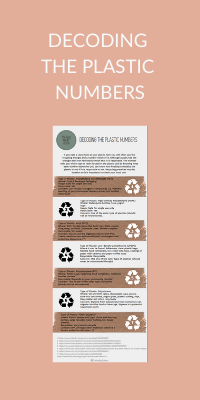
Plastics are not good for our environment and not so good for us, or our children so it’s best if we can reduce them in the long run, especially the bad types that potentially contain harsh chemicals.
However, if your home is like most modern homes, you will find a lot of plastic toys there. I am not suggesting throwing it out all at once, that would not be good for the environment.
My suggestion would be to get more educated about the different types of plastics. You may want to throw out or give away the plastic toys that are most likely to contain harsh chemicals. The next time you buy a new toy, you may then consider obtaining a more natural one.
I would also suggest keeping the plastic toys in closed containers, especially if they are inside your child’s bedroom, so they don’t release chemical fumes into the air. Doing this is very important if a plastic toy smells; it means that it is potentially off-gassing.
Regulations and understanding which types of plastics you may want to avoid
Children’s toy’s regulations vary between continents. Here in Europe, the rules are pretty strict, both in terms of safety, and chemicals.
Europe has a system called RAPEX (Rapid Exchange of Information System). It is an alert system that reports about compliance status for products sold within the EU.
According to an analysis from the RAPEX, banned chemicals were found in toys more than any other product type in 2018.
This high amount makes it more likely for non-compliant products to sneak into our homes, it doesn’t matter if it is a wooden or plastic toy.

Phthalates
Phthalates are one of the chemicals being phased out of toys in the United States, Canada, and Europe because of human health concerns.
They are chemicals used to make plastics like PVC, flexible and durable. PVC plastic is the worst type of plastics because it can contain Phthalates, Lead, Cadmium, and volatile organic compounds.
Here is an example from the RAPEX database mentioned above, to show you what type of products containing banned chemicals have been identified with the system:
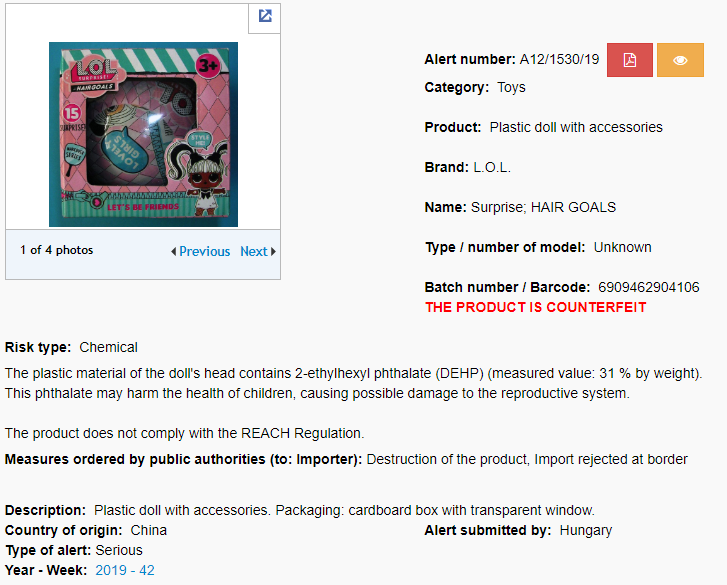
We can see in this example that this is a counterfeit of the popular L.O.L. dolls. This product was originated in China and contained illegal phthalates.
Luckily this product was stopped before imported. That is, unfortunately, not always the case as more and more products are being ordered online directly from China.
Qima, a company providing supply chain compliance solutions, randomly selected 35 Chinese-made plastic toys that were intended to be sold in Europe and the US. Approximately 25% of these toys were found to contain dangerous levels of phthalates.
This shows us, even though chemicals like phthalates are banned, there are still a lot of attempts to import these toys into these continents. This is especially true for less regulated areas like Asia.
When getting rid of plastic toys potentially containing phthalates, you want to check if they have recycling codes #3 or #6. However, toys do not always have these numbers.
If you have flexible plastic toys, like dolls, balls, or bath toys in your homes, these are the ones most likely to contain phthalates, especially if the toy is made in China and not from a European company.
There is no way of knowing for sure if the toy contains these chemicals, but if the toy smells a lot or even nice (sometimes the bad smell is masked with fragrances), it could indicate PVC materials. You may want to discard it or limit how much your child plays with it.
BPA and BPS
The other plastic I would recommend avoiding is plastics containing BPA or BPS. Plastics containing BPA are mostly being faded out in European products and US products. However, it is being replaced with a chemical called BPS. Here is a report, suggesting that BPS is as harmful as BPA.
Flame Retardants
Finally, the worst types of plastics are in items frequently found in homes, and often used as toys, remote controls. I know, most children love them.
The thing is that they are not intended to be put into small mouths. They follow completely different regulations and often contain flame retardants, which are not for our children.
The better plastics
My daughter LOVES LEGO (and I love building it with her when she allows me). I contacted LEGO to ask about the plastic they use. The answer I got was that they use ABS plastic. That is among the safest plastic-type, so I let it slip.
If the toys you are looking at have recycling codes on them, the better ones are #1,2,4,5. The #1 and #2 are mostly intended for single use.
Conclusion
We, as consumers, need to be educated in order to make buying decisions. We need to keep harsh chemicals out of our homes as we can. Even though regulations have never been more strict, we can not solely rely on them.
When choosing wooden toys, you want to make sure they are finished naturally with non-toxic paints and sealants. If it contains glue, you want to make sure it is also non-toxic.
Luckily several brands today are making beautiful high-quality wooden toys.
In my next post, I will introduce you to my favorite wooden toy brands!

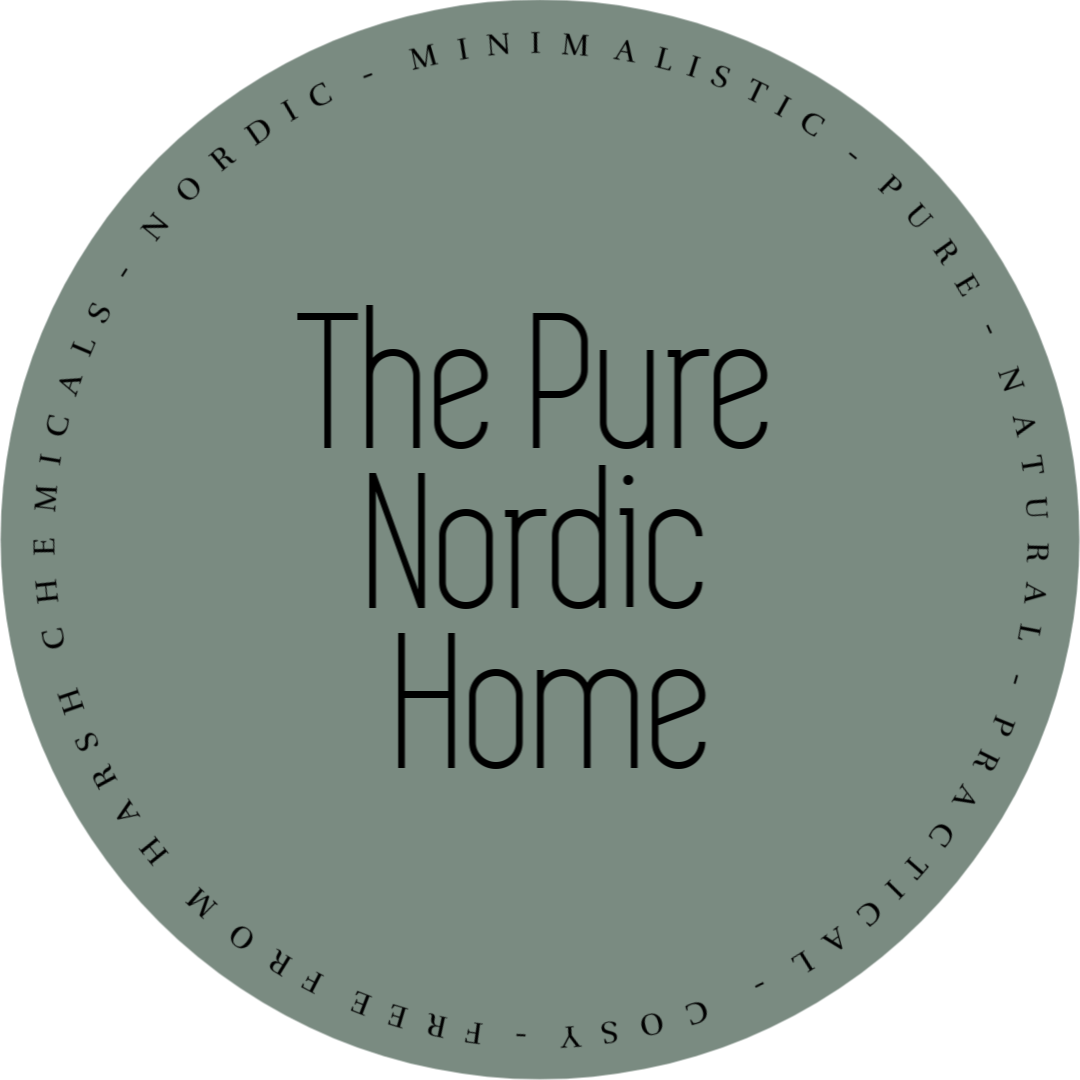



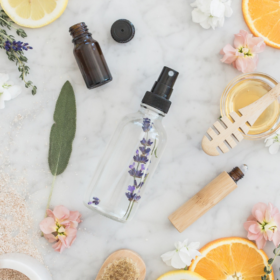
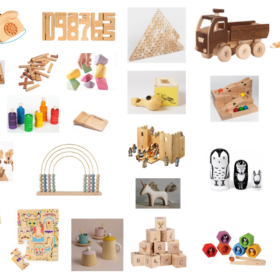
Micaela @MindfulMomma
This is SO important! We had some darling wooden toys and trucks when my boys were little. I know you can find a lot of great ones on Etsy – just be sure to read the details about stains & finishes!
admin
Yes, I could get stuck on browsing for wooden toys on Etsy for hours, there are so many beautiful toys there, and natural.
Emily Maze
Thanks so much for this information! We try to only choose wooden toys, but I didn’t know about choosing wood types. I’ve also heard good things about linseed (flaxseed) oil as a finishing option! I also had no idea there were fakes being sold on Amazon. That really sucks!!
admin
You are welcome Emily 🙂 There is always something new to learn in this journey of going natural/eco-friendly. Yes, linseed oil is a great finishing option. I know, it sucks 🙁
Shannon
Wooden toys are a great way to help avoid bringing more plastic into your home along with the chemicals you mentioned. And some of them are so cute!
admin
Yes, exactly Shannon! They are adorable 🙂
chelsea Duffy
I had never thought about plastic toys off-gassing! It was on my radar for furniture, rugs, paint, etc., but not toys. Thank you!
admin
I know, I didn’t either until I started researching a couple of years ago. You are welcome, and thank you for reading 🙂
Vladka
Wooden toys are my favorite. We use to have wooden train set which my kids enjoyed very much. We later donated it to our neighbours and their kids still plays wiht it. These toys last generations, they are easy to repare if needed and carry footprints of time. If it’s only me I would stick with wooden toys only.
admin
💚 That’s great to hear, this is exactly the beauty of wooden toys, they can be thrifted and used for a long time 🙂 I know, it can sometimes be hard to convince the others giving the gifts to avoid plastics and give wooden toys 🙈
Lucie
Great post. You make an excellent case for wooden toys. We do have some wooden toys, but I’ll have to double check to make sure they are safe as far as the paint finish goes. I’m also somewhat happy to hear that Lego is made of the safer type of plastic. My boys love lego.
admin
Thank you Lucie 🙂 Yes, it’s good to check, we don’t want lead near our children! I know, same in our house 🙂
Sarah Allen
Lots of great information in this, thank you.
admin
You are welcome Sarah, thank you for reading 🙂
Tessa Zundel
Thank you for the reminder to check before ordering on Amazon – I love their customer reviews! Thank you, too, for the breakdown on plastics. I was glad to know that about Legos because we have exactly 1,389 in this house!! At least, if feels like that many when I step on them. I would much rather step on a nicely sanded, soft-edged Montessori tree.
admin
Yes, their customer reviews are great, especially to find out about the fakes. You are welcome 🙂 Haha WOW! Great job to count all of them, I know we have a LOT! I was trying to make a good organization system, it will take days to sort all of them 🙈 Will probably make a blog post about it one day; How to organize LEGOs….
chelsea Duffy
I wish I had known all this when my kids were little. At least I have this information now for baby shower gifts 🙂 Thank you!
admin
Never too late! These are the best baby shower gifts, along with organic cotton ones :p
Kaylee
I adore wooden toys and try to only buy them for my friends and family with kiddos. This info is so helpful though! I always wondered what the symbols meant and honestly i never thought about the type of wood used! Thanks for the thorough information!
admin
That’s so nice Kaylee, these are great gifts. Great to hear that the info is helpful 🙂 I know, the symbols can be quite confusing 🙈 You’re welcome.
Natasha
This is a very thorough post on wood toys! I have a couple favorite wood toy brands I try to stick to because I trust them. Like you said, some wood toys are still toxic so it’s important to avoid cheap Chinese wood toys, especially ones that are painted. I was so proud when my toddler had a lead test at a recent checkup and her levels were far below average! It made me feel I’ve done a good job with her toys.
admin
Thank you, Natasha, I’m a researcher by nature and education, so my posts tend to get quite thorough, even though it’s not my intention :p I am just writing a blog post about my favorite ones, maybe we have some in common 🙂 Wow, that’s great to hear, well-done mama ❤️
Addie
We absolutely love our wooden toys, and have even thrifted some! I love how natural they are. Thank you for sharing those cleaning tips, I’ll be using them soon! I need to invest in some beeswax.
admin
Great to hear Addie! You are welcome, I was quite unsure how to clean the wooden toys, so I did some research 🙂 Beeswax is great.
second hand toys
What baby items would you accept as second hand gifts and what baby items would you buy brand new?
I’m expecting baby number one so there’s no hand me downs. I have friends,family and co workers offering me their used items which I greatly appreciate any help but I’m positive I want to buy a new car seat. I know a used one would probably be okay but that’s something I want to be sure about. What else would you rather buy brand new than accept second hand?